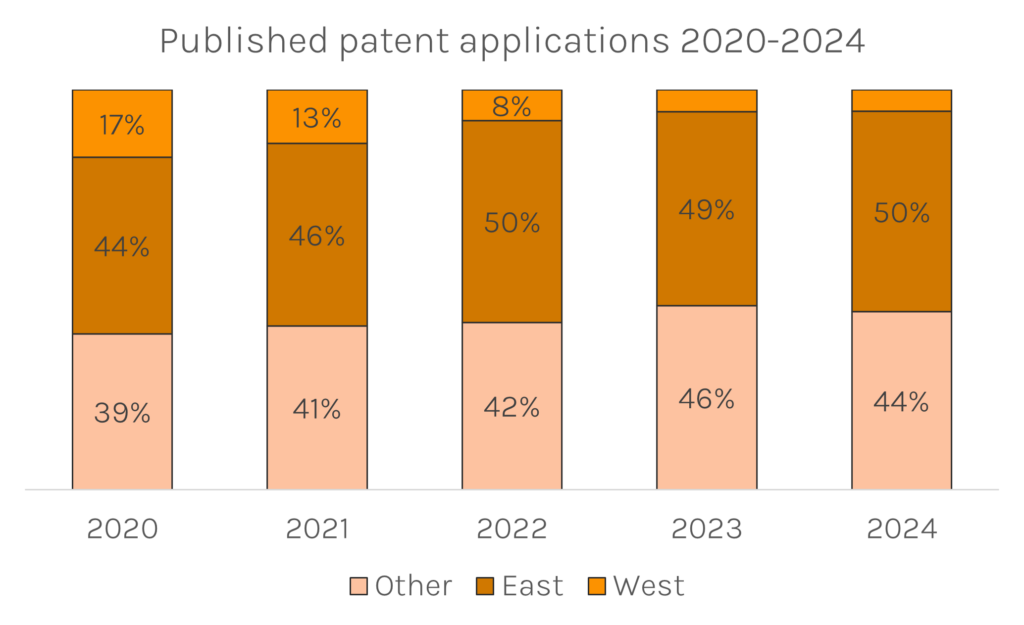20/10/2025
Smart grids are playing a vital role in moving the world towards a more sustainable and intelligent energy future. These advanced systems help balance supply and demand in real-time, integrate renewable energy into the national grid, support electric vehicles and improve our energy resilience at a time where energy independence is increasingly important.
Today’s smart grid innovations will shape tomorrow’s energy landscape. But whose innovations will these be? Where will the innovation take place, and what areas of technology will it likely focus on?
Patent applications, which have the ability to protect cutting edge innovation while it is commercialised, can provide insights into these questions.
Who?
There’s no denying that innovation in smart grids is picking up pace, and this is being driven by an interesting mix of global corporations, utility companies and leading research institutions.
Corporations such as Siemens, General Electric, Hitachi, Panasonic and Toyota are all heavily invested in smart grid innovation. These global tech giants are utilising their decades of experience, infrastructure and advanced automation capabilities to develop technologies that will power the smart grids of the future.
Meanwhile, in China, utility companies like the State Grid Corporation of China, which manages 80% of the Chinese grid, and the China Electric Power Research Institute are among the top filers of smart grid patents. They have been a significant driver behind a dramatic global shift in the location of most smart grid innovation from the western hemisphere to the east.
Research institutions are providing important contributions in developing cutting-edge technology in areas like Artificial Intelligence (AI), machine learning and predictive grid analytics in these technologies areas. For example, research institutions typically account for about 10% of patent filings, but account for over a third of all Chinese innovation for implementing AI in smart grids over the last 5 years.
Where?
In a landscape where Europe and North America were once the biggest hubs for smart grid innovation, there has been a complete global shift from west to east. China is now leading the way, with more patent filings in the sector than any other country.

Figure 1: showing the geographic origin of smart grid patent applications over the last 5 years
In fact, nearly half (46%) of all smart grid patent applications filed in 2023 came from Chinese applicants, with Beijing overtaking Tokyo and Seoul to become the world’s top location for smart grid innovation.

Figure 2: showing the city of origin for smart grid patent applications over the last 5 years
However, Chinese applicants typically do not extend their patent protection outside of China. By contrast, nearly 90% of British innovation in smart grids is protected in more than one jurisdiction.
Additionally, although there is a large volume of Chinese-originating patent applications for smart grids, China do not have a particularly strong specialism in this sector. In other words, the proportion of applications for smart grid technologies that are contributed by Chinese applicants is roughly the same as the proportion of total applications filed by Chinese applicants. By contrast, some European countries such as Switzerland and Denmark are focussing a greater proportion of their total innovation on smart grid technologies.
In Europe, Germany remains the front runner with the leading city, Munich, providing a similar number of smart grid applications as the UK. British organisations are also making important contributions, especially in specialist areas like demand response and dynamic grid balancing.
Which technology areas?
Perhaps unsurprisingly, different countries are seeking to solve the challenges posed by their own particular set of circumstances and energy mix. Necessity is, after all, the mother of invention.
For example, Chinese smart grid innovation is focussed relatively narrowly on how to manage power networks to interact with end-user applications. This is perhaps in response to the increasing size of China’s middle class. Smart grid innovation in the UK, on the other hand, is across a much more diverse range of technology areas but tends to focus on responding to energy demand. This is reflective of the UK’s unique energy mix and grid challenges, largely stemming from a geographic imbalance between energy supply in the north and energy demand in the south.

Figure 3: showing the contribution of the 5 major patent filing countries to the following smart grid technology areas:
electrical power generation, transmission or distribution (Y04S10); end-user applications (Y04S20); transportation (Y04S30); implement communications or IT (Y04S40); and power network operation (Y04S50)
Generally, interoperability and integration technologies are a growing innovation focus as more diverse energy sources such as solar, wind and battery storage are fed into the grid. Innovation in this space is seeking to ensure that our grid infrastructure will remain connected, flexible and responsive into the future.
The future of smart grid innovation
Any metric of divining the future should be viewed with some scepticism. But the patent data give some fairly strong pointers towards what the future might look like for smart grids.
First, China has established itself as the dominant thought-leader – although relatively few Chinese inventions are pursued globally, and innovation still seems to be responsive to the quirks and challenges of local infrastructure.
Second, the smart grid sector is responding strongly to the energy transition and facilitating movement away from a reliance of fossil fuels. Many challenges remain, not least how to ensure we do not waste the actual or potential energy generated by renewables, and smart grid technologies that help to integrate large-scale storage solutions to help smooth supply to the grid. At present these efforts are focussed on integrating with battery technologies, and could enable electric vehicles to become a mobile storage facility for the grid.
Last, but by no means least, the smart grid sector will be revolutionised by AI. We are already seeing explosive growth in the number of AI-related smart grid patent applications, and there is no sign that this trend will slow down any time soon. Although innovation growth in this sector is being driven by China, the potential for AI to be integrated into smart grids is vast and could be a focus of global smart grid innovation for many years to come.

Figure 4: showing the increased implementation of AI in smart grid patent publications over the past 5 years
In short, smart grids seem set to be more intelligent and more robust. They will be able to forecast the delicate balance of energy supply and demand and adjust the network infrastructure to meet that demand. They will be able to predict maintenance (and other) issues before they arise and take preventative action to extend the lifetime of the network. And, perhaps most significantly, they will enable a greater reliance on infamously unreliable renewable energy sources.
The future looks bright, smart, and green.
Sources:
A Global Review of Patent Data for Smart Grid Technologies – IEA and EPO report
Patents for enhanced electricity grids – EPO report – Dec 2024
This article is for general information only. Its content is not a statement of the law on any subject and does not constitute advice. Please contact Reddie & Grose LLP for advice before taking any action in reliance on it.



